By Gijsbert-Paul Berk
The Attraction of Spiders
This is not about the eight-legged arachnids – of which some species can be poisonous – but about four wheeled automobiles that appeal to the instincts of sporting men and women.
Driving an open sportscars without a roll bar can of course also be dangerous. But, as someone once remarked “driving a low and powerful machine with the wind blowing over your skull, is one of the most exhilarating sensations you can have with your pants on”. It is also one of the best ways to stop smoking.
All about the word
But let’s first try to avoid confusion because even for auto enthusiasts the designation ‘spider’ can mean different things. For most Italians ‘spider’ stands for an open sportscar with scant whether protection. But when French classic car buffs talk about a ‘spider’ they generally mean what in English speaking countries used to be known as a ‘dickey seat’ or ‘rumble seat’. Besides, in many countries spiders are often called ‘roadsters’. To make the confusion complete, except for Alfa Romeo other Italian manufacturers have started to call this body style ‘barchetta’ (little boat) and the French automaker Renault introduced in 1996 a small open two-seater which they called the Sport Spider. According to Lennart W. Haajanen, author of the “Illustrated Dictionary of Automobile Body Styles” (with a foreword by Karl Ludvigsen) ISBN: 0-7864-1276-3, spider with an ‘i‘ is the correct way. For historians it may be interesting to know that the name spider was originally used – in Europe – for light open horse drawn carriages seating two passengers, with a small seat behind them for the ‘groom’. That was the name of the manservant employed to take care of the horses (grooming or brushing the animals). His task was also to help female passengers to decent decently from their seats of a spider or other carriage.
Worse yet, some manufacturers have used the term Spider with an ‘i’ as well as Spyder with a ‘y’ for no apparent reason.
Spider is correct; Spyder is….
Porsche got the ball rolling in 1954 with the use of Spyder for the 550 model. But why did they use a ‘y’? According to Richard von Frankenberg, it was the Hoffman Agency in New York that suggested the name Spyder, because “they remembered that few sports-bodied American cars towards the end of the twenties had been called ‘Spyders.’” While some found the name and spelling odd, “…the Americans stuck to their guns and surprisingly quickly the car became known as the ‘Porsche Spyder.’” He also notes that very early coachbuilders used the term spider and often misspelled it as spyder –“perhaps the coachbuilders were poor spellers, perhaps they really spelt the word with a ‘y’ in those days…” Frankenberg also admits that the spelling is incorrect and should be Spider. #1 Well, too late now.
From Spider to Duetto
In past articles I have presented a number of aerodynamic experiments in car design. This time we will look at the evolution of open sports cars. Taking in account the interest of the subscribers of VeloceToday,, I have limited my sample to Italian and French models.
Apart from the driving sensations, one of the real advantages of open sports car bodies is their (relative) low weight. Compared to their closed counterparts this improves the power to weight ratio. On twisting mountain roads this means that the engine has more ‘punch’ available for storming up the passes. Reduced weight results in slightly less stress on the brakes when it comes to stopping. Open bodies also permit the lowest possible centre of gravity and will thus optimize the roadholding.
The drawbacks of topless coachwork are more drag and less torsional rigidity. The latter depends of course also on the construction of the chassis frame. Anyhow, only a few enthusiasts really care, because, let’s face it, most spiders are as seductive as Mrs. Robinson (Anne Bancroft) in The Graduate. I trust that you remember the film, the flashy red Alfa Duetto and the slightly provocative song by Paul Simon and Art Garfunkel.
Fanatic Alfisti know of course that the style of this Pininfarina-designed Duetto was evolved from a number of aerodynamic studies by the Turinese coachbuilder between 1956 and 1960. Pininfarina exhibited these fascinating Super Flow ‘concepts’ in various guises, at major European Motor Shows:
Turin 1956: Super Flow I with Plexiglas fenders, a Plexiglas canopy (roof) and tail fins.
Paris 1956: Super Flow II with steel fenders, but Plexiglas roof and tail fins.
Geneva 1959: Spyder Super Sport. no Plexiglas roof, no tail fins.
Geneva1960: Super Flow IV or Coupé Super Sport Speziale. The Super Flows concepts were built on the chassis of an Alfa Romeo 6C 3000, originally prepared by the factory for the 1953 Mille Miglia.
Ironically, Alfa decided to drop the very official Spider nomenclature with the introduction of the Duetto, as the word Duetto (which only lasted through the 1600 series anyway) replaced the word Spider. Like all good insects, however, Spiders would return.
The genesis of the breed.
Since the pioneer days of motoring, manufacturers have sold open two-seaters (including Panhard-Levassor with a spider in 1901). In fact at that time most cars were open. But very few were specifically designed as a sportscar. True, most early racing cars were two-seaters, because up to the 1926 / 1927 season the regulations stipulated that during races drivers had to be accompanied by a ‘riding’ mechanic. When this rule was abandoned the designers of Grand Prix cars gradually switched to sleeker single-seater (monoposto) bodies, as this reduced weight and drag.
However the ‘old’ competition-bred two-seaters fitted with narrow (cycle type) fenders and headlamps remained very popular as ‘road going’ machines. Think of cars such as the Amilcar CGSS, the Bugatti Type 40 or the Riley Brooklands, to name a few examples. The open two-seaters presented here have in common that they were all designed as pure sportscars. Some have been trendsetters and their styling inspired other coachbuilders or manufacturers. And most of them are now priceless classics.
#1 Porsche-the man and his Cars, Frankenberg, Robert Bentley, 1969, page 170
Now let’s take a look at some outstanding and salient spiders through the ages.
1932-1933 Alfa Romeo Spider (Touring of Milan)
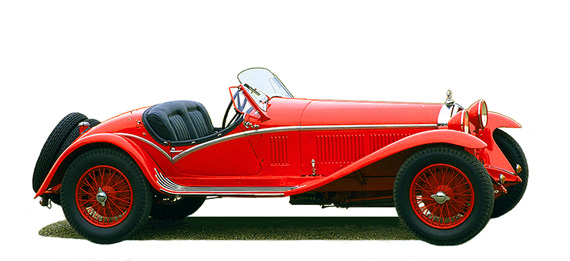
During the Jano era, from 1928 onwards, Alfa Romeo introduced a number of new models that set a benchmark for sportscars. The first was the 1928 6C 1500 Sport, fitted with a DOHC inline six of 1487 cc, followed by the C6 1750 (1752 cc). In 1931 came the 8C 2300, with an eight-in-line of 2336 cc. The Milanese firm produced chassis in two different wheelbase sizes: Lungo (long) or Corto (short). The first were generally used for four- to five seats passenger cars, the second for sporting two-seaters and competition machines. It seems that Alfa Romeo themselves also produced some coachwork and made it a practice to rebody their competition machines and sell them as road cars. But most of the longer chassis went to one of the many leading coachbuilders of that time such as Castagna, Ghia or Stablimenti Farina. The majority of the sports and competition cars were bodied by two coachbuilders who were both conveniently situated near the Alfa factory in Milan: Carrozzeria Touring and Ugo Zagato. These light-footed spiders, with their low and narrow cockpits, deep door cut-outs, long bonnets and sweeping fenders lines, are for many enthusiasts the genesis of superb Italian automobile design.
1934-1936 Fiat / Simca Coppa d’Oro Spider (Ghia of Turin)
For those who did not have the financial means to buy an Alfa Romeo Spider, Fiat introduced an attractive miniature look-alike in 1933. It was called the Fiat Tipo 108S. Its chassis was based on the Balilla 508 and its spider body designed by Ghia. Initially it was powered by a four cylinder side valve engine of only 996 cc but later got a cylinder head with pushrod operated overhead valves. After winning the 1100 cc category in the Coppa d’Oro del Littorio (a road race from Rome to Messina), this model became also known as the Fiat Coppa d’Oro Sports Spider. From 1934 onward the new founded make Simca, with its own assembly plant in Nanterre near Paris, marketed the model in France as the Simca 6 CV Sport.
1933-1935 Bugatti Type 55 Roadster (Jean Bugatti, Molsheim)
Jean (born Gianoberto) Bugatti, who tragically died in a car crash when trying to avoid a drunken cyclist, was a very talented designer. This Bugatti Type 55 roadster is one of his undisputed masterpieces. The first son of Ettore and Barbara inherited of course a lot of creative dna; the engineering genius from his father and the artistic flair from his grandfather Carlo, who had been a trendsetting designer and manufacturer of furniture and whose other son, Jean’s uncle Rembrandt, was a well known sculptor of animals. The Type 55, produced between 1932 and 1935, was in fact a road-going version of the Bugatti Type 54 Grand Prix machine. It was powered by a 2262 cc (138 c.i.) eight-in-line with twin overhead camshafts and a Rootes type supercharger. The roadster had a wheelbase of 2.750 m. (108.3 in) and weighted 816 kg (1800 lb.).
The superb lines of the Jean’s Bugatti Type 55 body inspired Xavier De La Chapelle around 1975 to manufacture a limited number of look-alikes powered by a BMW six cylinder engine. These cars were marketed under the name “Stimula 55″. De La Chapelle also made a series of so-called Junior Classics: among them a beautiful finished kid’s car version of the 55 in 6/10 scale.
1935-1936 Delahaye 135 Competition (Figoni & Falaschi, Paris)
Giuseppe (Joseph) Figoni emigrated as a young boy with his parents from Piacenza to Paris. As an apprentice he was trained to be a master panel beater and worked for several coachbuilders. Around 1925 he started for himself. But his dream was to design and build elegant and aerodynamic bodies on exclusive and sporting chassis. After he met Ovidio Falaschi, a businessman, who was also an immigrant from Italy, they established Carrosserie Figoni & Falaschi, at the Rue de l’Eglise in Boulogne-sur-Seine. Their partnership turned out to be very fruitful; Falashi’s capital and management skills allowed Figoni to concentrate on the activities in the workshop and on his designs. Figoni’s creativity did not stop with sculpting sheet metal into automobile bodies. He also invented and patented constructions for disappearing soft tops and sunroofs. At the 1935 Paris Salon de l’Automobile Figoni & Falaschi presented their new company with a low roadster on a Delahaye 135 ‘Competition Court’ chassis. It had a 3.5 liter ohv six-in-line engine, which equipped with three carburetors, made a top speed of some 160 km/h (100 mph) possible. Thanks to its streamlined body, its torpedo shaped and fully enclosed front fenders in striking and contrasting colors, their exhibit was one of the sensations of the French Salon. Figoni’s extrovert new styling was received with much enthusiasm and would soon be imitated by other French coachbuilders. But it attracted also some critical notes from leading auto journalists, because the all enveloping front and rear fenders would obstruct the cooling of the (drum) brakes and could cause brake fade.
Shortly after the Motor show the French painter Geo Ham sued Figoni and claimed that the design of this roadster was copied from one of his illustrations. Geo Ham (Georges Hamel) specialized in painting and drawing cars and airplanes and was well-known for the many splendid posters he designed for motor races and aviation events and the covers of race programs end prestigious French magazines such as l’Illustration. Fortunately an agreement was reached and Geo Ham subsequently made a number of drawings visualizing Figoni’s and his own ideas.
In 1936 Figoni & Falaschi introduced the first of a series sensationally-sculptured coupés on Delahaye Type 135 and Talbot-Lago T 150 chassis. Their style became known as ‘Goutte d’eau’ (water drop) Figoni must have listened to the critical technical journalist because these eye catching aerodynamic closed cars had ‘open’ fenders, so brake cooling was no longer a problem.
1936-1939 Darl’mat Peugeot (Georges Paulin & Marcel Pourtout, Paris)
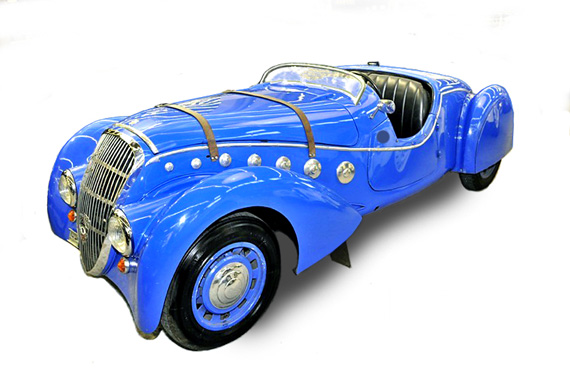
Emile Darl’mat owned a garage in the rue de l’Université in Paris, selling Peugeots. At the Salon de l’Automobile of 1936, the car manufacturer from Sochaux introduced their new 302 model, a shorter version of their futuristic and streamlined Peugeot 402 six window passenger car, launched just a year before. During a visit at the Peugeot exhibition stand, Charles de Cortanze, one of Darl’mat’s clients and a well known racing driver remarked that the chassis of the 302 fitted with the larger (1991 cc) engine of the 402 would make an excellent starting point for an attractively priced small sportscar.
Darl’mat approached the Peugeot factory with this idea and then his friends, the carrossier Marcel Pourtout and the talented dentist /designer Georges Paulin, who both lived and worked in the Paris suburb of Rueil Malmaison. In 1934 the three of them had worked together to develop the first Eclipse (coupé / cabriolet) on a Peugeot 601 chassis, based on the invention of a retractable hardtop patented by Paulin. This time the trio turned their energy and expertise toward creating a simple open sportscar. Their prototype had no windscreen and no doors, but was so well received that Darl’mat ordered Pourtout to produce a small series. Three Darl’mat 302 Spécial Sport roadsters were engaged in the 24 hours race at Le Mans 1937 and finished 2nd 3rd and 5th in their category. In the1938 event the Peugeot Darl’mat driven by Charles de Cortanze et Marcel Contet not only won the 2 liter class but was fifth in the overall classification. From 1936 to 1940 Darl’mats claimed many victories in races and concours d’élegance.
It is believed that some 105 Darl’mats were produced; 53 roadsters, 20 coupés and 32 cabriolets. Louis Renault was so impressed by the style and the success of the Peugeot Darl’mat that in1939 he commissioned Pourtout and Paulin to design and build about 25 more or less similar looking roadsters and cabriolets on the chassis of the four-cylinder Primaquatre. These cars were marketed as the ‘Primaquatre Sport’ by Renault’s subsidiary Saprar.
Postscript: Although Emile left this world in 1970 Darl’mat, the company that bears his name is still an important Peugeot dealer in the Paris area.
For more information about Darl’mat cars: amis.darlmat@wanadoo.fr
1938 Bugatti Type 57SC (Eric Giles & Corsica Coachbuilders)

This elegant Bugatti roadster looks typical French but its body is in fact 100 % British. Its history began in 1938. Geoffrey Giles (the Colonel) and his younger brother Eric Giles were enthusiastic Bugatti owners and respected founder members of the active British Bugatti Club as well. Geoffrey being the first Chairman and Eric had from 1930 onwards acted as Honorary Secretary. It is therefore not surprising that they had excellent relations with Ettore and his son Jean at the factory in Molsheim. In 1938 Geoffrey Giles was offered the chance to acquire a rolling chassis of a Type 57SC Bugatti. When Eric heard about this, he proposed to design a body for it and supervise its construction. Eric Giles had studied architecture and was a professional designer of home and office interiors. He had also done an apprenticeship with a coachbuilder.
Eric asked the advice of Jean Bugatti, who was very knowledgeable about body design and construction and much involved in outsourcing the production of coachwork on Bugatti chassis to Gangloff and other specialists. After some deliberations the Giles brothers selected Corsica in London for the job. Corsica was a small coachbuilding outfit, founded shortly after World War I by three brothers-in-law by the name of Charles Henry Stammers and Joseph and Robert Lee plus a certain Albert Wood, who had no family ties. They began making bodies in Corsica Street, North London, hence the name Corsica Coachwork. They specialized in building one-off bodies (bespoke coachwork in Kings English), many in aluminum or Dural but always adapted to the individual wishes and requirements of their ‘clients’. Corsica did not employ an in-house designer. If it seemed necessary to visualize their customers’ ideas, a contract draughtsman would be called in. However their craftsmen were professionals, so they had an excellent reputation for quality and many famous and loyal clients.
The Corsica Bugatti (chassis number 57593) has a wheelbase of 2,979 m. (117.3 in). The engine is a 3257 cc (198.8 in³) supercharged eight-in-line with twin camshafts, operating 2 valves per cylinder and dry sump lubrication.
Eric Giles’s design has a rather long pointed tail and large elongated fenders in the fashion of that time. The split windscreen mirrors the pointed Bugatti radiator. The contrasting striping running over the side of the body accentuates the length of the car. Some Bugattist have remarked that the styling reminds them of the 57 ‘Grand Raid’ roadster (with twin streamlined headrests), designed by Jean Bugatti for the 1934 Paris Motor Show and the look-a-like (without headrest) made by the Swiss carrossier Fritz Ramseir (Worblaufen). However, both these impressive cars were built on a long chassis and that gives them a complete different profile.
Therefore few can dispute that this unique Bugatti is a truly magnificent motor car. I am not the only one to think so. The Corsica BugattI, as it is sometimes called, won the best of show award at the 2000 Pebble Beach Concours.
PS. Last year CMC GmbH, the manufacturer of Classic Model Cars in Germany announced that they were bringing out a model of this 1938 Bugatti 57 SC Corsica roadster in scale: 1 /18. Tempting!
1939 Alfa Romeo C6 2500 Super Sports (Touring Superleggera body)
Have a good look at this black and white picture. It shows the prototype of the new Superleggera body by Touring for the 1939 Alfa Romeo C6 2500 Super Sports. From 1938 till 1943 Alfa Romeo produced 61 chassis, equipped with the latest version of their 2443 cc six cylinder twincam engine, developing 110 bhp at 4800 rpm. In March 1939 these machines were engaged in the 1500 kilometers long road-race Tobruk-Tripoly, finishing in 1th, 2nd and 3rd position. On April 28, 1940* some C6 2500 SS participated in the shortened Mille Miglia (for this reason also known as the Gran Premio di Brescia), that was however won by Huschke von Hanstein and Walter Bäumer in their BMW 328 roadster. Their BMW 328 roadster also had a lightweight body by the Milanese Carrozzeria Touring. The styling of the 1939 C6 Super Sports was a breakthrough for Alfa Romeo spiders. The elongated front fenders were no longer separate units but sculptured into the sides of the body.
The history of Touring started in 1926, after two lawyers, Felice Bianchi Anderloni and Gaetano Ponzoni, took over Carrozzeria Falco from Vittorio Ascari, its founder. They changed the name and the scope of the company. Anderloni, who had worked for Isotta-Fraschini and Peugeot Italia managed the sales, design and production activities and Ponzoni became responsible for administration and finance. Touring was one of the first companies to acquire the rights to manufacture the light and flexible Weymann bodies. This system was developed in France by Charles (Charly) Weymann and Maurice Tabuteau, both former pilots in the French Armée de l’Air. Between 1921 and the mid thirties it was very popular and Touring became a successful coachwork supplier to customers who had bought up-market chassis from Isotta-Fraschini and Alfa Romeo. When the fashion demanded more rounded shapes than the Weymann method allowed, Touring developed and patented their Superleggera system which consisted of a light body frame made up from thin steel tubes covered by a (non stress bearing) skin of aluminum panels.
Felice Anderloni had no technical training and had not the advantage of being brought up in a coachbuilding family, like Pinin Farina or Nuccio Bertone. But he proved to have an outstanding eye for design and many of the creations by Touring – such as this Alfa Romeo – are considered ‘summits’ of Italian coachcraft.
1940 Auto-Avio 815 (Touring Superleggera body)
Now look carefully at this photo. No, that’s not the same Alfa Romeo C6. It is the 1940 Auto-Avio 815. Ferraristi familiar with the life story of Enzo Ferrari will remember how he had started as a struggling but sometimes quite lucky driver for Alfa Romeo and later became their outstanding successful competitions manager. After the factory management, for financial reasons felt forced to reduce their efforts in auto sports, Enzo moved to Modena, using his Alfa Romeo dealership in that city to continue the racing activities of the Milanese cloverleaf team under the name the Scuderia Ferrari. But all this came to an end after a conflict with the Spanish engineer and engine designer Wilfredo Ricart. Ferrari converted his workshop in Modena to manufacture machine tools (among them grinding machines) and components for the aviation industry. As the contract he had previously signed with Alfa Romeo forbade him to use the name Ferrari or take part in motor racing during four years, this new company was called Auto-Avio Construzione. However, when young Alberto Ascari and his friend the Marques Lotario Rangoni Macchiavelli di Modena asked him to build them a pair of sports cars to take part in the coming Mille Miglia Enzo accepted the challenge. That Rangoni was a scion of one of the most influential families in the Emilia-Romagna area had probably been decisive. During a dinner party on Christmas Eve 1939, Ferrari told his collaborators of his meeting and with his engineering team of Alberto Massimino, Vittorio Bellentani and Enrico Nardi started preparing the design of the engine and chassis. For reasons of cost and time they decided to use a maximum of Fiat parts that were easily available. But they developed their own engine; an eight–in–line, with two overhead valve cylinder heads (from a Fiat Balilla) in tandem and a cubic capacity of 1496 cc. This predecessor of all future Ferraris was christened Auto Avia 815 (eight cylinders, fifteen hundred cc). The construction of the body was – but that is obvious when you see the photos – outsourced to Touring in Milan.



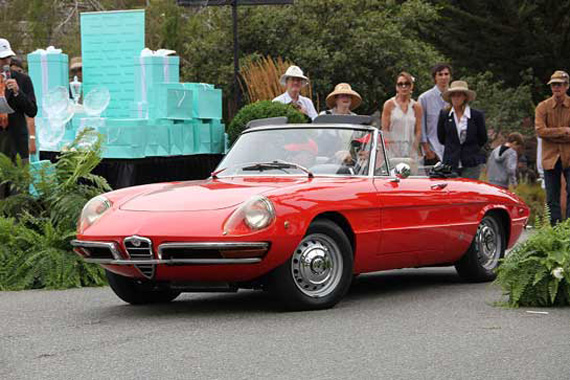
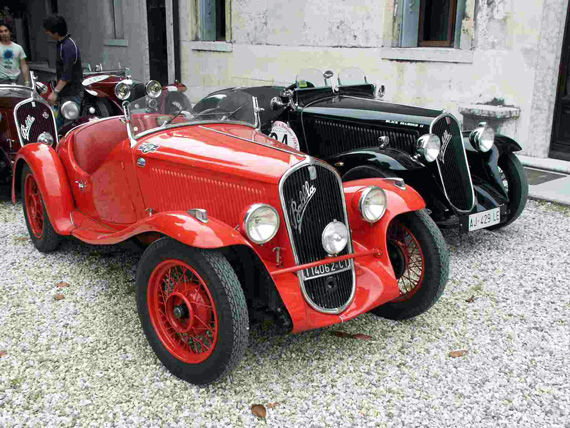
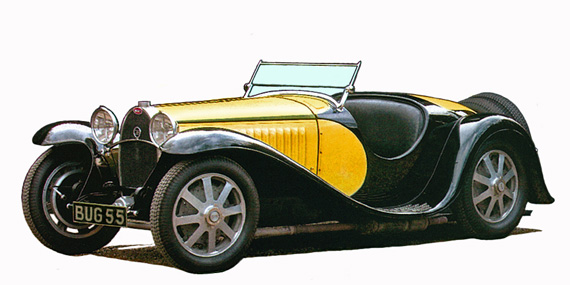



Hi, I was told that the word “spyder” was Dutch in origin!!! Dutch has two different spellings for the English vowel =i=(as in spider): ei and ij (as in eye). An egg in Dutch is spelled =ei = and a dike is spelled =dijk=. However, to avoid mispronunciations they decided to modify the spelling of =spijder as applied to an open carriage=(spider in English) and spell it =spyder=. Cheers, Adrian
Excellent article ! Keep up the great work !
What a brilliant article, one of the best for a while ( not to denegrate others of course! ) but what a shame that the Jaguar SS100 couldn’t have been included ( ommited for obvious reasons )
What a fantastic article! Thank you for clarifying the confusion around Spider/Spyder and the rest.
Judging by the side marker lights, I would guess that the picture of the Red Duetto is in fact a 1750.
Fine article. Perhaps in the USA at least, the Spyder spelling was used to try to claim the term for trademark branding and marketing purposes and to preclude its use by other manufacturers. A lot of money is wasted over such squabbling and etymology is the least of their concerns.
Not sure whether ‘spyder’ was originally Dutch, but Adrian’s explanation certainly applies to the Dutch car brand Spijker.
An excellent well written article. would have loved to have seen the years covered extended to the early 50’s where it could have included the Siata 208 spiders and/or the Gran Sports, that were done in the Stabilimente Farina Torino factory.
Some comments from the author:
Reply to Adrian van den Hoven.
I can well imagine why the French designation ‘spider’, for open horse drawn carriages with two wheels, was written as ‘spijder’ or ‘spyder’ in the sales brochures of Dutch carriage builders. Because the word ‘spider’ would be pronounced as ‘spieder’ or ‘speeder’ in the Dutch language and… in the German language as well. There are many Dutch words that have a French origin but have been phonetically adapted by the Dutch. Think of the word ‘jardin’ (garden), that gave its name to the famous ’Jordaan’ area in Amsterdam. There are also many words in French and English that came originally from the Dutch.
In particular naval words and expressions.
BTW. In Friesland, one of the Northern provinces of the Netherlands, an open horse drawn ‘spider’ used to be called a ‘sjees’, like ‘cheese’.
Reply to Reg J Lowe Esq,
You are right of course; the SS100 could have been included because it is indeed an open sports twoseater with tgreat attraction. I could also have included the small MG T series, That was in fact a prewar design as well, but the postwar MG TC was for many of my generation (in the USA as well) their first taste of a sportscar. However I had to limit myself and selected only French and Italian makes.
Otherwhise I would certainly also have included the BMW 328.
One of the most important Spyders in my opinion is the 2002 Maserati Spyder GT. It has the honor of re-introducing the Maserati to the US market after an absence of several years. The beautiful yet timeless design is from GIAGIARO. It has all of the mechanical attributes that a classic Spyder should have, powerful almost 400hp engine (Ferrari) trans axel, 6 speed transmission on the floor, Brembo disc breaks, convertible top Sky hook supension. I have driven this Spyder over 10 years and it still gets the “looks”. It’s has 60K miles and is still all original, even the paint, brakes and the top. The only problem that I have had is when it sucks a Vette into one of the exhaust pipes. Great car to drive (not easy) fun on the road and track.
In 1993, while vacationing at Jax Beach, Florida, I visited Brumos Porsche. A “well heeled” salesman entertained me with his encyclopedic knowledge of all things Porsche. His contention was that spyder was properly pronounced in the German dialect as “schpeeder.” (best I can do for phonetic spelling). Anyway, he explained that the Porsche Spyder would be pronounced, and otherwise interpreted as “Porsche Speedster.” Sounded like a reasonable explanation to me…
Very interesting article with some of my favorite cars. I would point out, however, that the “Best in Show” winner of the 2000 Pebble Beach Concour d’Elegance was in fact the Delahaye Torpedo roadster not the Corsica Bugatti. http://www.dochemp.com/jacques.html